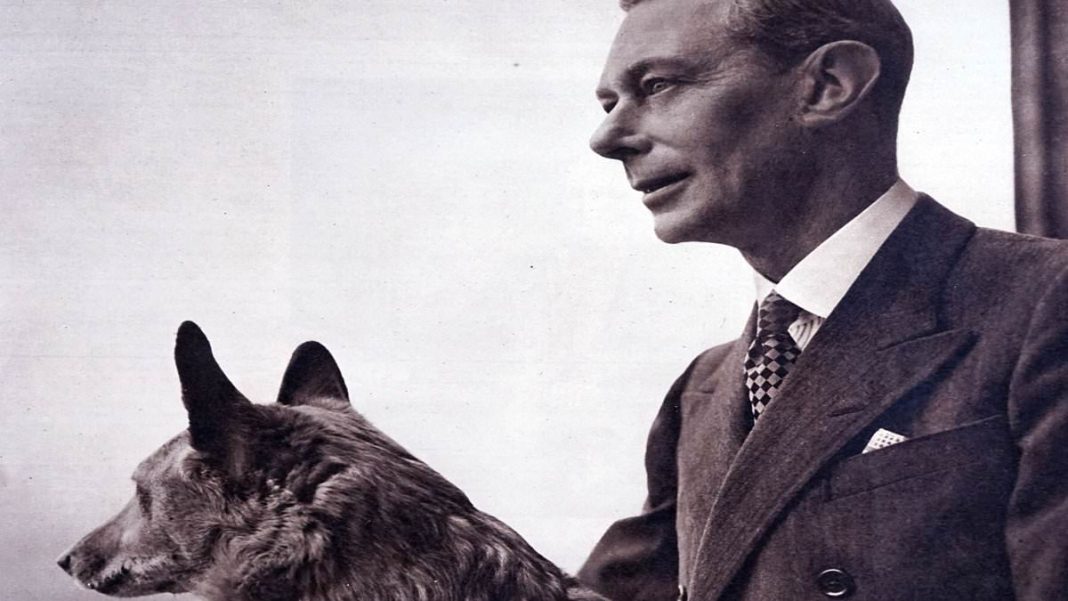The royal who had a ‘Hanoverian temper’ and ‘kicked a Corgi’,
King George VI lost his temper so badly during his battle with ill health that he allegedly kicked a Corgi across a room in Windsor Castle, a royal insider has revealed.
The shocking incident occurred while George was receiving treatment for an arterial blockage in his right leg.
According to Hugo Vickers, who wrote a biography of the Queen Mother, the King faced a ‘real danger of losing his leg’ in 1949, but by December George was firmly on the road to recovery.
Nevertheless, he remained a ‘difficult patient’ during his time bedridden and proved ‘hard to keep “amused and occupied”‘.
It was while recovering that the King apparently became more irritable and aggressive.
Vickers said: ‘His Hanoverian temper remained a problem. He had been known to kick a Corgi across the room at Windsor.’
Somewhat ironically, James Learmonth – the King’s surgeon – had advised George to ‘reduce the tempo of his life since thrombosis could occur if he was stressed either psychologically or physically’, Vickers wrote.
George’s wife, the then-Queen Elizabeth, nursed her husband throughout his health battle by taking on much of the burden of royal engagements while he recovered.
She also proved more than capable of calming her husband down when he lost his temper.
‘During one of the King’s “gnashes” Queen Elizabeth held the King’s arm high, appearing to take his pulse, and saying “tick, tick, tick” to lighten the moment,’ Vickers wrote.
Although the King’s leg was saved, his health crisis was far from over as physicians faced the daunting task of making him cut down on cigarettes.
George was a lifelong smoker who allegedly went through 50 cigarettes a day, meaning the King spent an estimated eight hours a day smoking.
Tragically, his habit took a toll on his body, leading to a swift deterioration in his health in the final years of his reign.
This started to affect the King’s ability to carry out his duties, with the heir to the throne – Princess Elizabeth – taking on more and more engagements.
By May 1951, the King was well enough to open the Festival of Britain, but afterwards he was forced to take an extended leave of absence.
This led to the cancellation of an official visit from the King of Norway just hours before he had been due to meet George.
In September that year, he had his left lung removed for was referred to at the time as ‘structural abnormalities’.
However, in reality, it was due to cancer. The King’s doctors kept this diagnosis both from the public and the monarch himself.
Although he did seem to be recovering from the procedure, the King died suddenly from a coronary thrombosis – or blood clot in an artery – five months later, in February 1952.
His death was a shock to the public and the Royal Family.
The King, in what would be his last public appearance, had seemed well when he waved off his eldest daughter at London Airport on January 31, 1952 as she and her husband, the Duke of Edinburgh, set off as his replacements on what was intended as a lengthy Commonwealth tour.
Joined by his wife and their younger daughter, Princess Margaret, the Royal Family said their goodbyes on the Tarmac before gathering on a rooftop to watch the plane take off.
Just six days later George passed away in his sleep.
News of her father’s death, and her immediate accession to the throne, reached Elizabeth while she was on safari in Kenya.
The tour was abruptly cancelled as the new Queen, then aged 25, rushed back to London.
The unexpected nature of the King’s death meant Elizabeth did not have a change of black clothes to mark his passing.
This led Queen Elizabeth II to add a new royal protocol that royals must always travel with a change of black clothes in the event of such a tragedy.
As the second son of George V, the King was a famously reluctant monarch who had acceded unexpectedly to the throne in December 1936 after the dramatic abdication of older brother Edward VIII.
Christened Albert after his great-grandfather Prince Albert in the last years of Queen Victoria’s long reign, and known as ‘Bertie’ to his family and friends, George VI had been a shy and sickly child who suffered from a stutter and had always been content to live in the shadows of the more charismatic and glamorous Edward.
George went on to see the country through the darkest days of World War Two, which was the defining period of his reign.
When the Royal Family elected to stay in London for the majority of the war, their fortitude won them the enduring respect and affection of the British people. They even subjected themselves to food rationing and restrictions on the depth of their bathwater.







